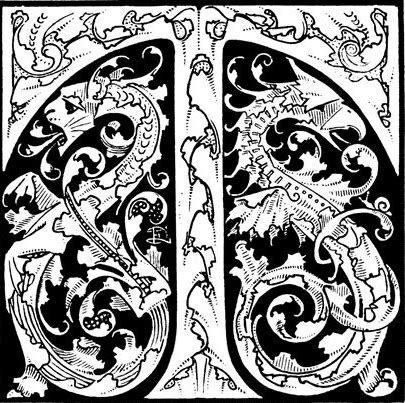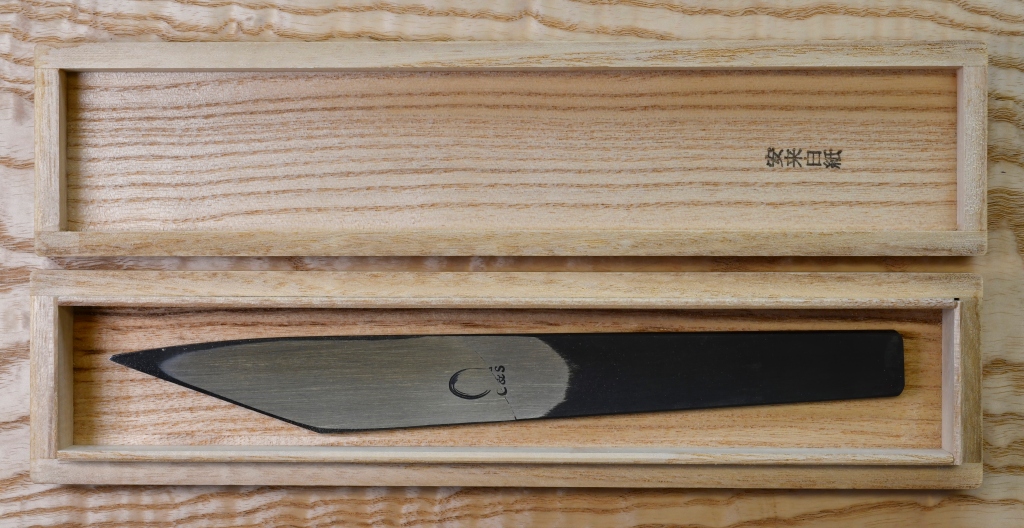
May it be a light to you in dark places, when all other lights go out.”

he title of this article references two things: A little knife, and a little wooden box, both uniquely and traditionally Japanese.
The Knife

The knife in question is called a “kiridashi kogatana” (kee/ree/dah/she koh/gah/tah/nah)) or just “kiridashi” for short. Your most humble and obedient servant has written about this Japanese woodworking and general utility knife at great length in this article: The Kiridashi Kogatana Knife.
Kiridashi are Japan’s traditional utility, carving and woodworking knife. Indeed, until about 30 years ago, every school child in Japan was required to have a little one in their school bag for sharpening pencils, cutting paper, carving wood, and many other classroom tasks. But it has always been a serious tool for serious work by adults, one owned and used daily by nearly every craftsman in the country for centuries, at least.
But what are the advantages of a plain, flat, thin knife like this? A good question, one that most Westerners who haven’t trained in Japan naturally ask, and one that deserves a good answer. So let’s list some.
- Sharpness: Just as our chisels and planes, the blades of our high-quality, professional-grade kiridashi are of hand-forged laminated construction with a hollow-ground ura which makes them the easiest and quickest little cutters in the world to make frightfully sharp. And don’t forget, the love of sharp things is deep in the Japanese blood. You may find the articles at the following links amusing: In The Blood, Kireaji
- Carry and Storage: Kiridashi are easy to store and carry because they are flat and thin. Hardware stores sell cheaper versions of these little cutters with wooden scabbards, but this makes them bulkier. Our kiribako boxes are perfect for safe storage.
- Precision: It’s easier to make fine, precise cuts with a kiridashi than a thick, double-beveled Western-style knife with wooden scales because the flat, thin blade provides a better view of the work, provides better sensory feedback, and with fingertips located safely closer to the cutting edge, improved control.
- Cost effective: The kiridashi is the very essence of a cutting tool with no frills, no handle, and no expensive surround stereo system, just a simple, easily sharpened and fiercely-sharp blade.
Of course, kiridashi can be purchased with wooden handles and full wooden scabbards, or the user can make one to his taste easily enough. Your humble servant has made scabbards for those kiridashi he brings to jobsites for the extra protection they afford during transit, but they aren’t otherwise necessary and offer no advantage in the workshop, where I use a bit of cardboard as protective sheath instead.
So that explains the “Knife,” part of this article’s title, but what about the “Presentation Box” part? That’s next.
The Box

Being so popular in Japan, there is an extremely long history here of gifting better-quality kiridashi kogatana knifes to friends, families and fellow workers who use them. In fact, those procuring a kiridashi as a present have historically purchased them with a special presentation box of a type called a “kiribako” made of a wood much loved in Japan called “kiri ” (paulownia tomentosa). These little boxes typically have handwritten calligraphy on the lid describing the contents.
Regarding kiribako, It’s not an overstatement to say that one cannot fully understand the Japanese people until one understands kiri wood and kiribako.
Kiri trees have large leaves and beautiful flowers, grow extremely quickly, and produce a lightweight fragrant wood Japanese ladies love for cabinetry and chests used for storing clothing. Indeed, it was once common for fathers to plant a kiri tree at the birth of a daughter, and have the wood of the same tree made into a dowry chest or cabinet for her marriage when the time was right.
Due to popular requests going back years, we now carry kiribako boxes with hand-written calligraphy designed to fit our hand-forged kiridashi kogatana knives. They make excellent gifts and presentation pieces. And they’re not at all expensive.
Our boxes are solid-wood traditional construction, made in Japan by a Japanese specialist box-maker located in Niigata Prefecture, with a tight-fitting slip-on lid. They also come with the characters “Kiridashi” written by hand in ink on the lid along with the blacksmith’s name (Mr. Masuda) and his personal chop. Inside the box is a stamp that says “Shirogami” referring to the type of steel Mr. Masuda uses to make our kiridashi.
Given some time, and at no additional cost, Beloved Customers can request personalized calligraphy, such as the recipient’s and/or presenter’s name, the occasion, and even a date, in the Japanese language of course.
If you’re looking for an unusual, extremely traditional and classy gift for someone that likes beautiful, useful, sharp tools, this might be just the ticket. You won’t find them anywhere but C&S Tools. If you’re interested, please see the pricelist at the link below. To contact us please use the form below.
YMHOS
If you have questions or would like to learn more about our tools, please click the “Pricelist” link here or at the top of the page to find our products and use the “Contact Us” form located immediately below.
Please share your insights and comments with everyone in the form located further below labeled “Leave a Reply.” We aren’t evil Google or fascist facebook and so won’t sell, share, or profitably “misplace” your information. May all my kiridashi chip and break if I lie.
Leave a comment